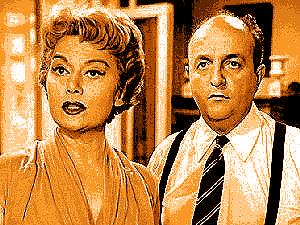Film Review
Yves Allégret began his career working as an assistant to his older
brother Marc Allégret and the legendary cineaste Jean Renoir. He made
his directing debut in 1943 with
Les Deux timides, although it wasn't
until he made
Dedée d'Anvers
(1948), the first in a series of noir-influenced masterpieces, that he was
taken seriously by the critics. After
Les Orgueilleux (1953), Yves
Allégret's career began a slow but irreversible decline as the director
became increasingly prone to the prevailing populist tastes of the time.
This is illustrated by the film he released in 1957,
Quand la femme s'en
mêle, a somewhat formulaic comedy-thriller based on a popular novel
by Jean Amila entitled
Sans attendre Godot.
Whilst the film is far from being Allégret's best and pales in comparison
with contemporary hard-boiled policiers by Jean-Pierre Melville (
Le Doulos) and Jacques Becker (
Touchez pas au grisbi),
it nonetheless makes an enjoyable romp, effectively combining several diverse
genres into a satisfying star-studded potpourri. With its slightly
humorous asides,
Quand la femme s'en mêle certainly does not
take itself too seriously but, thanks to Charles Spaak's slick screenwriting,
neither is it dull or ridiculous. Released at a time when the traditional
film noir gangster movie was beginning to feel a tad passé in France,
this film played a part in the establishment of a related genre, the parody
policier. Georges Lautner is the French director who had most success
with this emerging genre, his popular
Monocle films being a prelude to his
memorable box office winners
Les
Tontons flingueurs (1963) and
Ne nous fâchons pas
(1966).
One area where
Quand la femme s'en mêle cannot fail to impress
is in its cast - the film boasts an acting ensemble that most self-respecting
filmmakers would sell their soul for. Supremely elegant in her Pierre
Balmain's dresses, that legend of stage and screen Edwige Feuillère
is the ideal choice for the role of Maine, a sarcastic and classy gangster's
moll who ultimately shows she has more balls than her ineffectual male cohorts.
Doing their best not to look like the weaker sex next to
Feuillère's ballsy bitch (and failing)
are two other French cinema icons: Bernard Blier, the comedy gangster par
excellence, and Jean Servais, happily parodying his tough gangster roles
in such films as Jules Dassin's
Du rififi chez les hommes
(1955). The biggest revelation in the supporting cast is Bruno Cremer, who,
in his second screen role, makes an immediate impact as an icy cold killer.
Having distinguished himself in
La
317e section (1965) and
La
Bande à Bonnot (1969), Cremer would become a mainstay of French
cinema for the next three decades, although it was on French television that
he found his most memorable role, as Jules Maigret in a popular long-running
series.
Sophier Daumier also makes her mark as a young innocent who manages to get
herself caught up in a world of violence and romantic intrigue; she would
later form a successful stage double act with her husband, Guy Bedos.
Making an impressive screen debut in a role that appear to have been tailor-made
for him is a young and surprisingly sympathetic Alain Delon - who better
to play the super-efficient bodyguard Jo, a precursor of his most iconic
role in Jean-Pierre Melville's
Le Samouraï
(1967)? Immediately after this, Delon went on to work with Allégret's
brother Marc on
Sois belle
et tais-toi (1958), a similar comedy thriller in which the actor
rubbed shoulders with another screen icon in the making, Jean-Paul Belmondo.
The dream cast is completed by a distinguished band that comprises Jean Lefebvre,
Pierre Mondy, Pascale Roberts, Jean Debucourt and Yves Deniaud.
Quand la femme s'en mêle may not have been as enthusiastically
received by the critics as Yves Allégret's previous films, but it
managed to attract a very respectable audience of 0.9 million on its first
release in France. On the strength of its remarkable cast line-up alone,
it deserves to rate as a minor classic of the French comedy policier genre.
After this, Yves Allégret made a few films of note -
La Fille de Hambourg (1958)
and
Germinal (1963) - but, perhaps
demoralised by the tragic death of his son in 1955, he now seemed to lack
the immense creative flair of his early years. In his final decades,
the director fell well short of the promise of those remarkable films he
had made in the late 1940s, early 1950s, crowned by his lyrical masterpiece
Une si jolie petite plage
(1949).
Quand la femme s'en mêle
feels like a last hurrah for a director who knew that his best days were
way behind him.
© James Travers, Willems Henri 2013
The above content is owned by frenchfilms.org and must not be copied.
Next Yves Allégret film:
La Fille de Hambourg (1958)
Film Synopsis
Henri Godot, the head of a Parisian-based criminal gang,
has begun an amorous liaison with Maine, the former girlfriend of one of
his equally ruthless rivals, Bobby. Infuriated by this double betrayal,
Bobby swears to have his revenge and it isn't long before armed hit-men are
on Godot's tail. Luckily, Godot has an efficient bodyguard, Jo, who
manages to keep his employer out of harm's way. An attempt to kidnap
Maine is similarly frustrated. An awkward situation becomes even more
complicated when Maine's former husband Félix Seguin shows up unexpectedly,
accompanied by his precocious 17-year-old daughter, Colette. The latter
has yet to forgive Maine, her natural mother, for walking out on her father.
The reason for Félix's trip to Paris is soon revealed. He has
recently discovered that his second wife's death in a fire was not accidental but
an unfortunate consequence of an insurance scam orchestrated by Auguste Coudert
de La Taillerie, the wealthy proprietor of the Galéries Modernes.
Félix hopes that with Godot's help, he can put in motion a plan of
revenge. The two men begin by paying a call on the insurance agent
who dealt with the claim. Before he commits suicide, the compromised
agent leaves a letter which incriminates La Taillerie. Hearing of this,
the latter offers Jo a large sum of money if he will steal the troublesome
letter for him. By this time, Jo and Colette are a lot closer than
Godot would like, and so Colette is the one tasked with purloining the letter.
The attempt is thwarted by Maine, who, being as keen to see justice done
as her ex-husband, accompanies Félix and Jo to La Taillerie's resplendent
château. In the ensuing confrontation, the crooked entrepreneur
and Jo are gunned down. His revenge lust satisfied, Félix departs
with his daughter, leaving Godot and Maine behind in Paris to sort out matters
with the police.
© James Travers
The above content is owned by frenchfilms.org and must not be copied.


